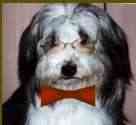
Hobo's Advice Column (TM) (banners) ©read me |
Welcome to my advice column.
Remember, I am only a dog like you. My opinions are to the best
of my knowledge but are only opinions, researched or what I feel is correct..
The writer of this page is not responsible for any actions the reader
may take as a result of reading this column. If that is
OK with you, keep reading. If not, then go back and enjoy the other
pages. You can address your questions to Hobo by email with
the topic Hobo's Advice (click on my picture) |
|
Main Advice Page |
Current Column -
Stop jumping up on visitors Do you have any advice on jumping up. My dog does insists on getting over excited when meeting people. The people at her school have nick named her the kangaroo dog. Having said this, she does seem to respond to a stern command of "leave" - (well sort of). Problem is, there are some of our friends and family who do mind the jumping and bouncing when they greet her. She doesn't really know when and with whom this behavior is acceptable. Jumping up when greeting is actually a happy greeting. Some think this is based on the pack ritual - as with wolves who rub, smell and even lick. Jumping up is an effort to get closer to your face. Sometimes it is a dominance thing, the dog dominates by jumping on a person. While reading this, I would like to suggest the word "Down" or "Off" (a command you do not use for other activities) in place of "NO" This is instructive rather than just a shout. Following are some methods you might try. But remember, you must be consistent. Allowing this behavior with family will only promote it with others. Positive methods: We always suggest positive methods. Grab the dog by the collar when it starts to jump up say NO and Sit. Hold the collar under the chin and pull the dog into the sit if you need to. Once down give heaps of praise. The Gentle Leader folks feel that the best way of training the dog is to set up the situation and use their collar and a short lead (leash). Have a person come in, when the dog starts to jump up say no and pull back on the leash. Praise when the dog is under control (again I feel that also having them sit is a good idea). The gentle leader is a halter like collar - you do not jerk the lead but instead pull back. If you use a regular collar and lead, you might snap back on the lead and say "OFF". Negative methods The most common way to stop jumping up is to say "Down" or "NO" (use OFF) and lift a knee so it hits the dog in the chest. At the same time the hands are raised palms out towards the dog's face (a hand signal). Later the hands and the OFF should be enough. Once the dog is under control you praise. I think adding the sit command is even better, then praise when they sit. This method should be reserved for the "nothing else works" category. This is a negative technique (kneeing could cause pain), Most negative technique ( but even famous authors who support positive techniques have advanced this method if nothing else works): Slap the dog on the nose while saying OFF Remember 1 - in the case of the dog desiring to great by "getting in your face"
- as a happy greeting - there is a strong reward in your squatting down
and satisfying that desire. This is OK for you, but visitors may
not like the idea. You could, for example, praise when the dog sits
and lower
2 - corrections must always be made. If you allow jumping up one time (or even ask for it) and then later are not in the mood, you will confuse the dog. If you correct outdoor, while taking a walk, and then allow the dog to jump on a family member (or yourself), you will confuse the dog. The key is consistency. As always, this advice has been researched and reflects the best of my knowledge. In this case most of the knowledge came from a few selected dog training books and also information I have obtained from Gentle Leader. I like the idea of the situation set up and pulling back using a leash the best to start off with - I think it is OK to try with a normal collar and lead - use the snap back method. But I will also say that if you have time to work with the dog, the gentle leader is an interesting device - also remarkable to training to heal. The dog needs to get used to it (instructions are included by Brad). The pulling to a sit method is often the most convenient - especially if you just happen to open the door and someone is there and the dogs great them. Hope that helps.
|